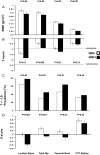Low bone mass and high bone turnover in postmenopausal human immunodeficiency virus-infected women
- PMID: 19965927
- PMCID: PMC2840861
- DOI: 10.1210/jc.2009-0708
Low bone mass and high bone turnover in postmenopausal human immunodeficiency virus-infected women
Abstract
Context: Low bone mineral density (BMD) is commonly reported in young men and women with HIV infection, and fracture rates may be higher. With effective antiretroviral therapy (ART), the HIV population is aging. However, little is known about the skeletal status of postmenopausal women.
Objective: We aimed to assess the effects of HIV infection and ART on BMD and bone turnover in postmenopausal minority women.
Design, setting, and patients: A prospective cohort study was performed in 92 HIV+ and 95 HIV- postmenopausal Hispanic and African-American women.
Main outcome measures: We measured BMD by dual-energy x-ray absorptiometry, fracture prevalence, serum levels of inflammatory cytokines (TNFalpha, IL-6), bone turnover markers, calciotropic hormones, and estrone.
Results: HIV+ women were younger (56 +/- 1 vs. 60 +/- 1 yr; P < 0.01) and had lower BMI (28 +/- 1 vs. 30 +/- 1 kg/m(2); P < 0.01) and estrone levels. Prevalence of T scores below -1.0 was greater in HIV+ women at the spine (78 vs. 64%; P < 0.05), total hip (45 vs. 29%; P < 0.05), and femoral neck (64 vs. 46%; P < 0.05), and Z scores adjusted for BMI were lower in HIV+ women at the same sites. Serum TNFalpha, N-telopeptide, and C-telopeptide were significantly higher in HIV+ than HIV- women, particularly those receiving ART. HIV+ status was independently and negatively associated with spine and hip BMD after adjustment for age, ethnicity, BMI, and alcohol.
Conclusion: The lower BMD, higher prevalence of low BMD, and higher levels of bone turnover markers detected in HIV+ postmenopausal minority women could place them at high risk for future fractures.
Figures



References
-
- Luther VP, Wilkin AM 2007 HIV infection in older adults. Clin Geriatr Med 23:567–583, vii - PubMed
-
- Effros RB, Fletcher CV, Gebo K, Halter JB, Hazzard WR, Horne FM, Huebner RE, Janoff EN, Justice AC, Kuritzkes D, Nayfield SG, Plaeger SF, Schmader KE, Ashworth JR, Campanelli C, Clayton CP, Rada B, Woolard NF, High KP 2008 Aging and infectious diseases: workshop on HIV infection and aging: what is known and future research directions. Clin Infect Dis 47:542–553 - PMC - PubMed
-
- Carr A, Miller J, Eisman JA, Cooper DA 2001 Osteopenia in HIV-infected men: association with asymptomatic lactic acidemia and lower weight pre-antiretroviral therapy. AIDS 15:703–709 - PubMed
-
- Dolan SE, Huang JS, Killilea KM, Sullivan MP, Aliabadi N, Grinspoon S 2004 Reduced bone density in HIV-infected women. AIDS 18:475–483 - PubMed
Publication types
MeSH terms
Substances
Grants and funding
LinkOut - more resources
Full Text Sources
Medical

